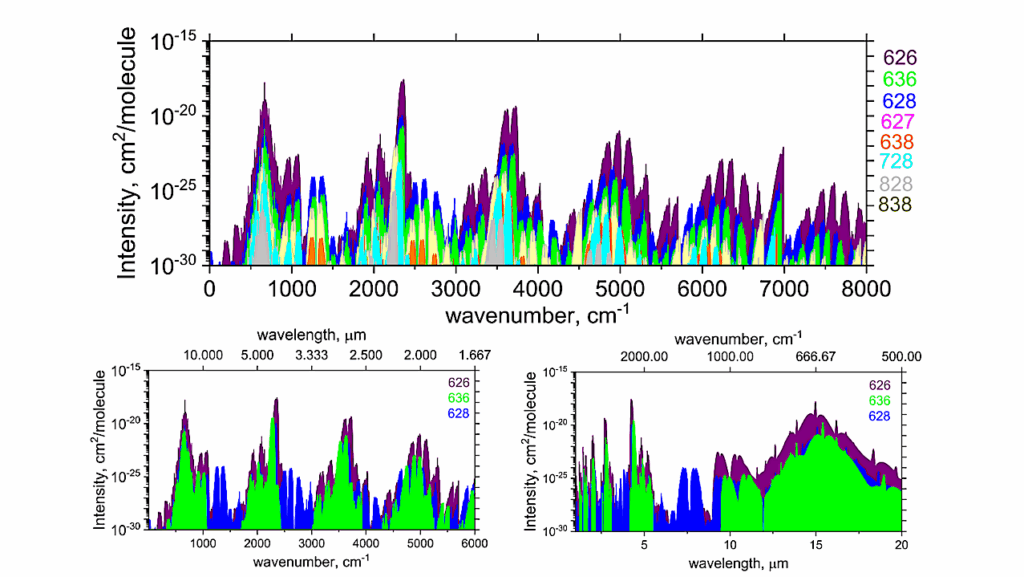Using Stars To Study Titan’s Atmosphere

With its thick atmosphere and mysterious weather patterns, Saturn’s largest moon, Titan, is an alien world ripe with discovery potential.
Using Gemini North, one half of the International Gemini Observatory, and the SOAR Telescope, both operated by NSF’s NOIRLab, and in collaboration with other global observatories, a team of astronomers observed two chance alignments of Earth, Titan, and a distant bright star to learn about the moon’s atmosphere and build improved models of its winds.
In the field of astronomy, inspiration can strike unexpectedly. Such was the case in November 2021 when a group of astronomers were having lunch and discussing a common point of interest: Saturn’s largest moon, Titan. During their discussion, Martin Cordiner, a researcher in astrochemistry and planetary science at the NASA Goddard Space Flight Center, mentioned some interesting data from a recently published paper he had worked on that involved observations of Titan’s atmospheric winds. The conclusions drawn from this study would present the group with a mystery, and disentangling this mystery would not only require the power of eight different telescopes across two countries to capture a chance alignment of Earth, Titan, and a distant star, it would also bring together an international collaborative team of astronomers.
“Here was an opportunity to learn something new,” says Eliot Young, a principal scientist at the Southwest Research Institute’s Space Studies Department. “It’s certainly a testament to the importance of meeting people face-to-face and not just having Zoom meetings.”
Titan is the only other world in our Solar System to have a thick atmosphere and stable surface liquid. But unlike Earth, Titan’s rivers, lakes, and seas are composed of hydrocarbons, including methane and ethane — compounds that exist on Earth in the form of gas. The extremely cold temperature of Titan liquifies these natural gases, which are then circulated through the atmosphere as clouds, fog, and precipitation, following stages similar to the water cycle on Earth.
This similar, yet alternative, atmospheric circulation system makes Titan an enticing object to study. “It’s pretty remarkable that we can even see the weather patterns on another planet,” says Young. Observations of Titan’s weather patterns can help build a deeper understanding of how its nearly Earth-like atmosphere formed.
Seeing Through Titan’s Haze
To study Titan’s general circulation, astronomers observe the winds at different atmospheric ‘layers’, or altitudes. This is challenging though, since Titan’s atmosphere consists of a smog-like haze formed by chemical reactions with methane molecules. So, scientists have developed different techniques for probing Titan’s haze layers.
One way to measure Titan’s winds is by observing an occultation — a chance alignment in which light from a distant star passes through Titan’s atmosphere. As the star moves behind Titan, astronomers can measure the slow dimming of light to produce what is called a ‘lightcurve’. At the center of the lightcurve, a unique feature called a ‘central flash’ appears, when Titan’s atmosphere acts like a refractive lens and bends the star’s light toward a focal point. With adaptive optics, astronomers can even image the refracted light before and after the central flash when it appears as two bright spots on Titan’s edge. Characteristics of the lightcurve and the refracted light reveal information about Titan’s atmospheric winds. An occultation observed in 1989 revealed that Titan’s winds are fastest at mid-northern and mid-southern latitudes and slowest near the equator.
Another method to probe Titan’s haze layers uses Doppler wind measurements. Depending on the speed and direction of the winds, the frequency of light emitted by different molecules within the atmosphere will be Doppler shifted, like the sound of a car horn moving farther away from the listener. By measuring how much the molecule’s light is shifted, astronomers can estimate how fast the winds are moving. Cordiner and his colleagues used this method to observe Titan in 2016 and 2017 with the Atacama Large Millimeter/submillimeter Array (ALMA) in the Atacama Desert in Chile. What these measurements showed, however, were fast winds at the equator and slow winds in the northern and southern latitudes, contradicting the results of the 1989 occultation observations.
When Cordiner shared these results with his lunchmates, the discrepancy piqued the interest of the rest of the group. Young, who has a background in observing occultations, turned to Juan Lora, assistant professor of planetary science at Yale University, who had been working on global circulation modeling of Titan’s atmosphere, and asked what behavior his models showed. To everyone’s surprise, Lora said his models closely agreed with the occultation results but with some additional asymmetries, showing fast winds at mid-latitudes that oscillate from year-to-year between the northern and southern hemisphere. It became apparent that the current understanding of Titan’s winds had some significant holes in it, a realization that would spark a collaborative effort to reconcile the data with the models.
“This seemed like a really encouraging way to resolve a conflict between two observations that should be good and compare them to a model, so that’s what we decided to do,” says Young. “And with the ALMA group, the occultation group, and the modeling group it got to be a pretty big collaboration.”
Astrobiology








